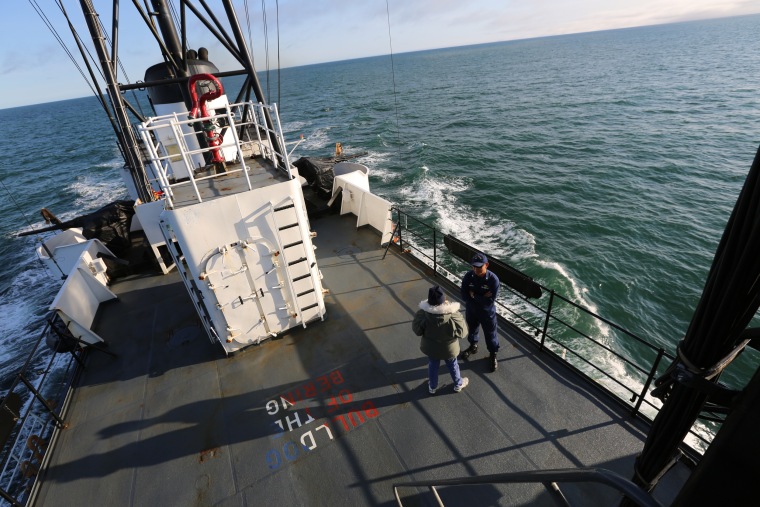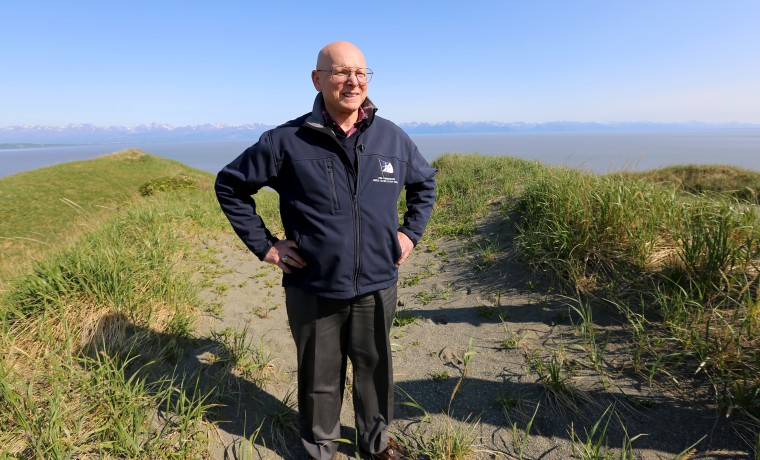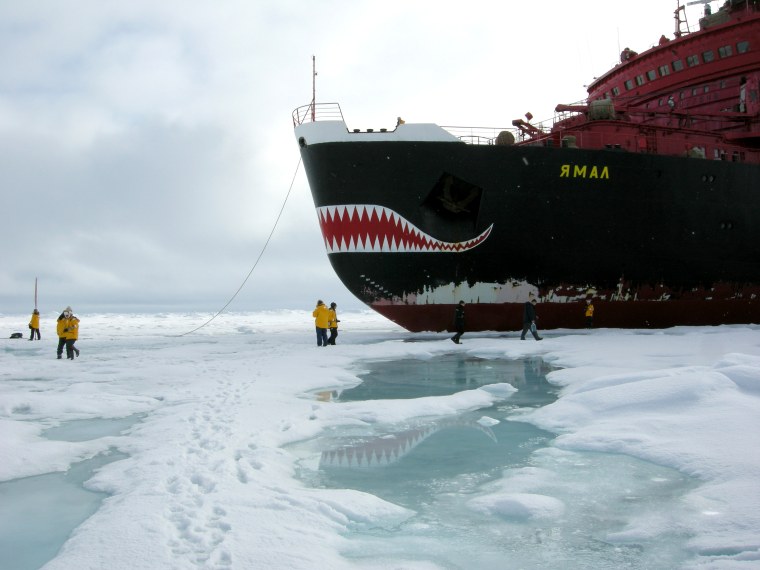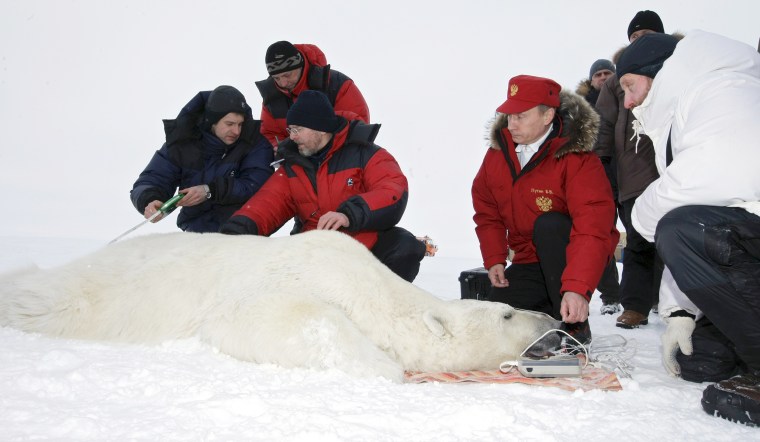ABOARD THE COAST GUARD CUTTER ALEX HALEY — In the vast Arctic, melting ice caused by global warming is bringing new opportunities, and new problems, to a region that could be the next front in a very cold war — a battle that some say America is losing to the Russians.
It's the Coast Guard's job to navigate these turbulent waters — no easy task with an aging fleet stationed off the southern coast of Alaska and tight purse strings nearly 5,000 miles away in Washington, D.C.
The cutter Alex Haley recently made the long trip from the Gulf of Alaska to the Chukchi sea for a 60-day safety and security mission dubbed "Arctic Shield" — and invited NBC News along for part of the patrol.

The painstakingly maintained 44-year-old vessel, nicknamed the “Bulldog of the Bering,” has an old-fashioned brass steering wheel and engines named after famous spirits like Jack Daniels and Johnny Walker.
“A lot of these old engines are like these bottles of liquor,” Lt. Adam Smude explained. “They can be fun and they can be exciting. But they can also cause a lot of headaches.
There are other headaches on the horizon of what retired Adm. Robert Papp, the U.S.' top man in the Arctic, calls "one of the last frontiers left in the world."
Rising temperatures have brought more sea traffic to the northern quarters of the planet – along with warnings that nearly 150 years after the United States purchased Alaska from the Russians, it’s fallen behind in the race to dominate the Arctic.
Dozens of commercial ships now traverse the Northwest Passage connecting the Pacific and Atlantic oceans. Using the route, which skirts the top of Alaska and Canada, is estimated to be 30 percent cheaper than hauling goods via the Panama Canal.
Next summer, a U.S.-flagged cruise ship, the Crystal Serenity, plans to take more than 1,000 passengers through the passage, which not long ago was considered too treacherous because of nearly year-round ice pack.
"The Arctic is the Mideast of this century."
The big melt has also made the natural treasures — oil, gas and fish that were frosted over for centuries – newly accessible to the eight countries with territory in the Arctic.
“In the near future, you might find U.S. troops up in Alaska because of security reasons,” said Bob Reiss, who wrote a book on the changing Arctic, “The Eskimo and the Oil Man.”
“The consumer goods that we buy, even on the East Coast, if they end up coming over the top of Alaska through the Northwest Passage, will get cheaper. Our energy might be coming from the Arctic. Our conflicts with Russia might be exacerbated because of the Arctic. Our rivalry with China will certainly heat up in the Arctic.”
The Arctic, he says bluntly, “is the Mideast of this century.”
The U.S. is currently chair of the intergovernmental Arctic Council, and President Barack Obama just became the first commander-in-chief in history to visit the area – but many experts and some government officials think the region isn’t getting the attention and money it deserves.
“We are clearly behind in the Arctic and it’s something that needs to be addressed,” said Papp, who ran the Coast Guard from 2010 to 2014 and now serves as the U.S. special representative to the Arctic Council.

Reiss puts it in even starker terms: “A Coast Guard admiral told me a couple of years ago, if this was a ballgame, the U.S. wouldn’t be in the fields. We wouldn’t be in the stands. We wouldn’t be in the parking lot. We are last.”
Bucking to be first is Russia, which beefed up its military presence in the north, especially after the conflict in Ukraine and its annexation of Crimea. It’s building search-and-rescue stations, rehabbing airports and missile sensors, and staged military exercises to protect its burgeoning oil fields just weeks ago.
“The Russian military has identified the Arctic as a probable place for war in the coming century over resources. Vladimir Putin has called the Bering Strait the next Suez Canal,” Reiss said. “They had immense war games in May. And when the Russians have a war game, well, who’s the opponent? The opponent is NATO, so the opponent is us.”
Russia has 41 icebreakers, some nuclear-powered, to help it get around. The United States only has two aging icebreakers, and just one of them is assigned to the Arctic.
New icebreakers cost about $1 billion and take 10 years to build, so unless funding is approved very soon, the U.S. could find itself falling even further behind.
Two weeks ago, Obama called for an accelerated building plan, but that has to be approved by lawmakers. And as Papp notes, if the Polar Star were to break down in the ice today, there would be no way to rescue it.

The U.S. also doesn’t have a deep-water port in the Arctic, so the Alex Haley and its sister ships have to operate out of Kodiak. Earlier this year, the Army Corps of Engineers tentatively approved a plan to build out the Port of Nome. That’s 650 miles to the north of Kodiak, but well south of the Bering Strait, the Pacific gateway to the Arctic.
The commander of NORAD has cautioned that the sensors installed in the Arctic during the Cold War will be obsolete in 10 years. He’s pushing for Canada to install new ones that could track shorter-range cruise missiles, but there is no timetable yet.
Then there’s the underwater land grab. Other members of the Arctic Council have put in claims to extend their continental shelf and expand the amount of seabed they can explore and exploit for natural resources. Russia’s application is the size of France and Spain combined.
The U.S. slice of the ocean floor could be twice the size of California, but it can’t even make a bid because it has not ratified the Law of the Sea Treaty, which has been held up by Senate Republicans even though the Bush and Obama administration, the oil companies and environmentalists all support signing it.
Papp says it’s “embarrassing to me to see that we are not a part of that treaty, where every other major maritime country in the world has signed on to it and is using it as a tool, as a venue to peacefully resolve issues that are happening at sea.”

As Reiss sees it, the problem is in part one of classroom geography. Alaska’s width could cover the mainland from California to North Carolina, but on many maps it shows up as a tiny inset.
“It looks like a flea. It looks smaller than Rhode Island,” he said.
Papp says he knows that one of his jobs as chair of the Arctic Council is to convince the public that the sparsely populated, mysterious frontier at the top of the world is as important as the Lower 48.
“The maritime routes of the world are changing,” he told NBC News. “The focus on the rest of the world is on the Arctic. And we really need to focus the people of the United States on these new challenges.”
After all, he added, “we are a people that have always risen to a challenge.”
Tomorrow: Life at the Top of the World: Whale, Caribou and $10 Milk
